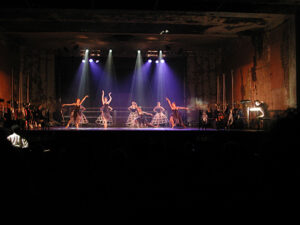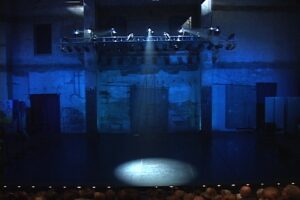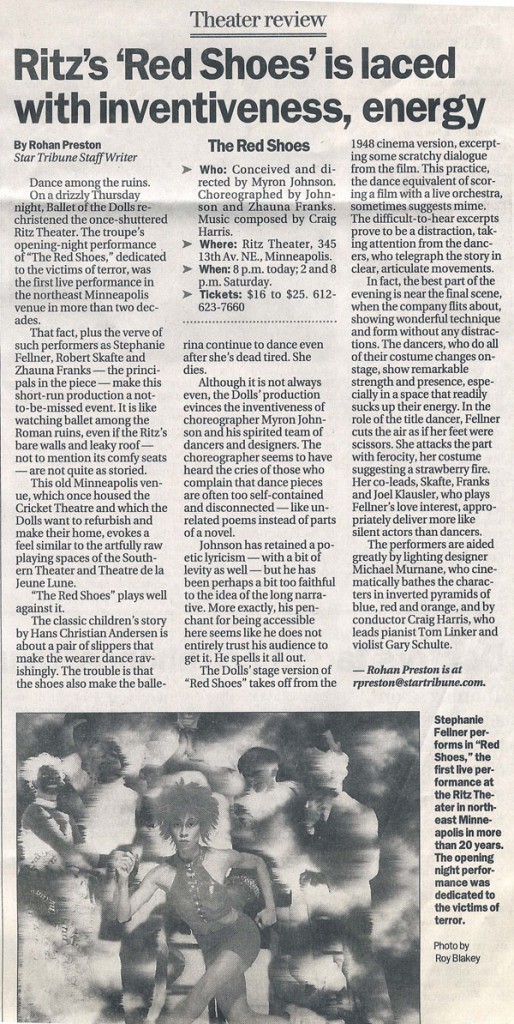Achieving Artistic & Life Balance as Illuminated in The Red Shoes Movie
A common theme in the life of artists is the actual and/or perceived tension between pursuing one’s creative goals and needs, while creating a balance that includes life partners and children. The artists’ life is not known to attract abundant financial resources, which can be challenging raising children in a stable environment with reasonable prospects for a fruitful future. Abundance can be attained in many ways, however, and I don’t subscribe to the romantic notion that one must live the Bohemian life in a shabby attic in Paris or New York City to create and produce meaningful art. I cannot ignore my own experience with this tension, however, as I reconfigured my life plan as I tried to achieve balance. That act of “reconfiguration” is in itself a bit of an artistic endeavor.
In 2001 and 2002 I collaborated with dance theater company Ballet of the Dolls’ Artistic Director and Choreographer Myron Johnson to create the production “The Red Shoes.” The show is based on Hans Christian Andersen’s fairy tale, which was incorporated into a movie directed by Michael Powell and Emeric Pressburger in 1948. Hans Christian Andersen’s story is based on a young girl’s love of dance. A shoemaker presents her with a magic pair of dance shoes at a street festival, and dance takes control over her when she puts on the shoes. She continues to dance until exhaustion, and can only stop when her feet are chopped off.
“The Red Shoes” movie incorporated Andersen’s tale as a story within a story – actually more appropriately characterized as a ballet within a story within a story. An authoritarian ballet company Director Boris Lermontov rules over his protégés, demanding complete submission to his rules, which include not allowing personal relationships to interfere with their art. He brings a new dancer, Victoria Paige, into the company, and cultivates her to play the leading role in their new ballet, The Red Shoes, composed by the company’s resident composer, Julian Craster. Victoria falls in love with Julian, creating a conflict of tragic proportions between Vicki, Julian, and Lermontov. Vicki’s internal conflict between her passion for dance and her love for Julian leads her to commit suicide.
At the time of these productions I was serving as Ballet of the Dolls’ Executive Director, as well as Executive Director of The Ritz Theater Foundation. We were building the company, and raising funds to renovate the Ritz Theater to become the permanent home for the company and to serve as a multi-use performance venue for the arts community in the Twin Cities. I wrote and produced the music for the show in the middle of the night, after what was usually 12-hour work days. My girls were 10 and 11 years old at the time, and I was also volunteering many hours in their classrooms and helping to build arts funding to support arts integration and artist residencies for the school to enrich their programming at a time when arts education funding was being slashed in the public school system. In those days sleep was not my companion, and tension related to achieving life balance was very present for me. I strove to view the situation holistically as numerous forces working together, rather than as different activities struggling in opposition, a goal that I’m sure had successful and unsuccessful moments.
The original production of Ballet of the Dolls’ “The Red Shoes” was produced at the Ritz Theater in Northeast Minneapolis, before the renovation.

Our original venue for the production cancelled on us with very short notice, and we had to scramble to come up with a plan to produce the show. We decided to bring attention to our initiative to develop this historic yet abandoned and dilapidated 900-seat movie theater by mounting a production on site, even though there was no stage, no electricity, no plumbing, the roof leaked, and the seats were filthy and dusty. We obtained the necessary permits, brought in a stage, put cloth over the seats, brought in electricity generators and a full lighting grid, a sound system, portable toilets, and buckets to capture the rain water so we could mount a production that as it turned out took place the week immediately following the 9-11 disaster, in the middle of a rain storm. It was both eerie and magical. This is photo of the Ritz Theater production.

The text heard in the show is derived from the original 1948 movie. In the original production the dialog was integrated into an electronic soundscape, taken directly from the movie sound track. Time was short; the budget was tight; and this design had its advantages and effect, but it was not ideal. It was difficult to hear the dialog at times in the boomy raw space, and slaving live performers to an electronic sound track has never been a great performance design. We redesigned this aspect of the show to have the dialog performed by live actors when we remounted the production in 2002 at Theatre de la Jeune Lune’s beautiful warehouse space. In the 2002 production all male voice roles were performed by Bradley Greenwald, and female voice roles were performed by Julie Tehven. We also refined other aspects of the show in this version. This is the stage set for Ballet of the Dolls’ production of “The Red Shoes,” presented at Theatre de la Jeune Lune in 2002.
These video excerpts from the 2002 production illustrate three key scenes from the dance theater production:
Irina’s Swan Song
In this early scene in the movie and show, the ballet company’s prima ballerina, Irina, is performing what will turn out to be her last role with the company, a situation that is instigated by her deciding to get married, something that company Director Lermontov insists is the death act to a dancer’s career: “You cannot have it both ways…the dancer who relies upon the doubtful comforts of human love with never be a great dancer…. NEVER!!!!” Irina’s Swan Song foreshadows the tragic results that we experience later in the show.
The Red Shoes Fairy Tale
This excerpt captures sections from the premiere performance of the company’s new Red Shoes Fairy Tale Ballet, based on Andersen’s tale.
The Red Shoes – Red Shoes Fairy Tale from Interference Arts on Vimeo.
Trio Triage
This scene follows the successful premiere performance of The Red Shoes Fairy Tale Ballet, with the new prima ballerina Victoria Paige performing the lead role to music composed by Vicki’s lover, Julian Craster, the composer of the music score. As illustrated in the scene, the tension Vicki experiences isn’t caused solely by company Director Boris Lermontov. Julian is also pressuring Vicki to give up her passion for dance and go away with him, which creates a tightening vice between both sides of her world that in the end becomes intolerable.
Star Tribune’s Rohan Preston reviewed both productions, describing the show and context. He captured the magic and vitality of the show in the reviews, as well as the sound challenge that we had in the Ritz production, and our “redemption” in the 2002 show.


THE RED SHOES CREDITS
Directed and choreographed by Myron Johnson
Choreography for “Ballet One and Ballet Two”, rehearsal director – Zhauna Franks
Original music and sound design by Craig Harris
Lighting design by Michael Murnane
Costume designs by Candy Kuehn
Conductor & Electronic Soundscapes: Craig Harris
Violinist: Gary Schulte
Pianist: Tom Linker
Voices: Bradley Greenwald and Julie Tehven
CAST OF CHARACTERS
Stephanie Fellner Victoria “Vicki” Paige, a young ballerina
Robert Skafte Boris Lermontov, Company Director
Joel Klausler Julian Craster, a young composer and conductor
Stephanie Karr-Smith Grisha, Ballet master / shoemaker
Zhauna Franks Irina, prima ballerina / chorus
Dancers: Heather Cadigan, Lisa Conlin, Michael deLeon, Maryann Johnson-Smith, Valerie Torres, Cari Riis, Colleen Tague
